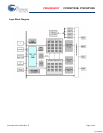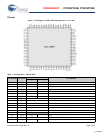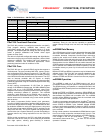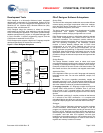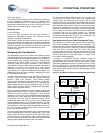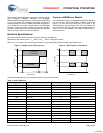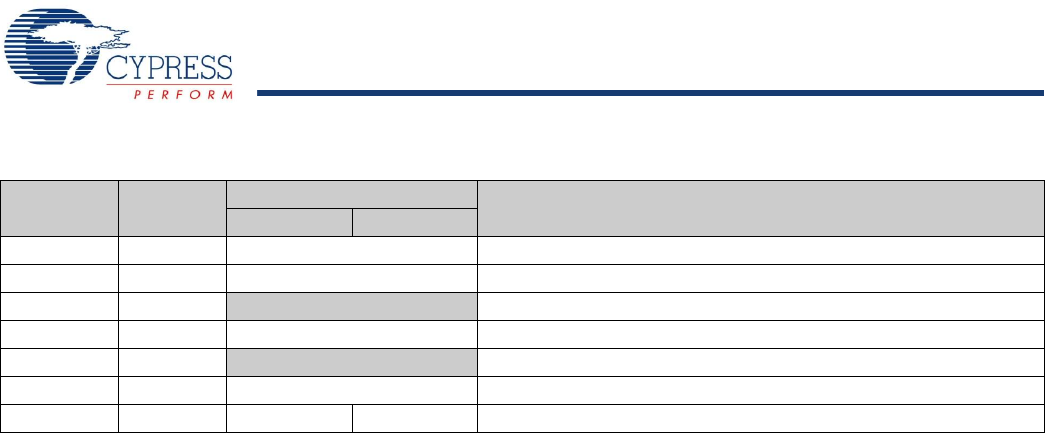
PRELIMINARY CY8CNP102B, CY8CNP102E
Document #: 001-43991 Rev. *D Page 5 of 38
PSoC NV Functional Overview
The PSoC NV provides a versatile microcontroller core (M8C),
Flash program memory, nvSRAM data memory, and
configurable analog and digital peripheral blocks in a single
package. The flexible digital and analog IOs and routing matrix
create a powerful embedded and flexible mixed signal
System-on-Chip (SoC).
The device incorporates configurable analog and digital blocks,
interconnect circuitry around an MCU subsystem, and an infinite
endurance nvSRAM. This enables high level integration in
consumer, industrial, and automotive applications, where
preventing data loss under all conditions is vital.
PSoC NV Core
The PSoC NV core is a powerful PSoC engine that supports a
rich feature set. The core includes a M8C CPU, memory, clocks,
and configurable GPIO (General Purpose IO). The M8C CPU
core is a powerful processor with speeds up to 24 MHz, providing
a four MIPS 8-bit Harvard architecture microprocessor. The CPU
uses an interrupt controller with 25 vectors, to simplify
programming of real time embedded events. Program execution
is timed and protected using the included Sleep and Watch Dog
Timers (WDT).
On-chip memory encompasses 32 KB Flash for program
storage, 2 KB SRAM for data storage, 256 KB nvSRAM for data
logging, and up to 2 KB EEPROM emulated using Flash.
Program Flash uses four protection levels on blocks of 64 bytes,
allowing customized software IP protection. The nvSRAM
combines a static RAM cell and a SONOS cell to provide an
infinite endurance nonvolatile memory block. The memory is
random access and is accessed using a user module provided
with the device.
The device incorporates flexible internal clock generators,
including a 24 MHz Internal Main Oscillator (IMO) accurate to 2.5
percent over temperature and voltage. The 24 MHz IMO can also
be doubled to 48 MHz for use by the digital system. A low power
32 kHz Internal Low speed Oscillator (ILO) is provided for the
Sleep timer and WDT. The clocks, together with programmable
clock dividers (as a System Resource), provide the flexibility to
integrate almost any timing requirement into the PSoC NV
device.
GPIOs provide connection to the CPU, and digital and analog
resources of the device. Each pin’s drive mode may be selected
from eight options, allowing great flexibility in external
interfacing. Every pin also has the capability to generate a
system interrupt on high level, low level, and change from last
read.
nvSRAM Data Memory
The nvSRAM memory block is byte addressable fast static RAM
with a nonvolatile element in each memory cell. The embedded
nonvolatile elements incorporate QuantumTrap
®
technology
producing the world’s most reliable nonvolatile memory. The
SRAM provides infinite read and write cycles, when independent
nonvolatile data resides in the highly reliable QuantumTrap cell.
Data transfers from the SRAM to the nonvolatile elements (the
STORE operation) takes place automatically at power down, and
data is restored to the SRAM (the RECALL operation) from the
nonvolatile memory on power up. All cells store and recall data
in parallel.
Both the STORE and RECALL operations may be initiated under
software control. The PSoC NV user module embedded in the
PSoC Designer Tool provides all necessary APIs to initiate
software STORE and RECALL function from the user program.
nvSRAM Operation
The nvSRAM is made up of an SRAM memory cell, and a
nonvolatile QuantumTrap cell paired in the same physical cell.
The SRAM memory cell operates as a standard fast static, and
all READ and WRITE takes place from the SRAM during normal
operation.
During the STORE and RECALL operations, SRAM READ and
WRITE operations are inhibited, and internal operations transfer
data between the SRAM and nonvolatile cells. The nvSRAM
provides infinite RECALL operations from the nonvolatile cells
and up to 200,000 STORE operations.
To reduce unnecessary nonvolatile stores, AutoStore
®
is ignored
unless at least one WRITE operation is complete after the most
recent STORE or RECALL cycle. Software initiated STORE
cycles are performed regardless of whether a WRITE operation
has taken place. Embedded APIs provide a seamless interface
to the nvSRAM.
During normal operation, the embedded nvSRAM draws current
from Vcc to charge a capacitor connected to the V
CAP
pin. This
stored charge is used by the chip to perform a STORE operation.
If the voltage on the Vcc pin drops below V
SWITCH
, the part
automatically disconnects the V
CAP
pin from Vcc and STORE
operation is initiated.
79 HSB# Weak Pull up. Connect 10kΩ to Vcc.
80 Vcc Power Supply Voltage
81 - 85 NC
Not connected on the die
86 - 90 Vss Power Ground
91 - 98 NC
Not connected on the die
99 NV_C Connect to Pin 61 (NV_C to EN_C).Weak Pull up. Connect 10kΩ to Vcc.
100 P0_7 IO I Analog Column Mux Input, GPIO
Table 1. Pin Definitions - 100-Pin TQFP (continued)
Pin Number Pin Name
Type
Pin Definition
Digital Analog
[+] Feedback




